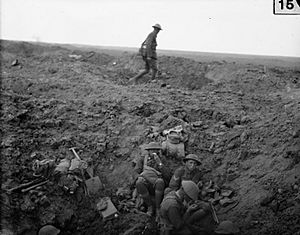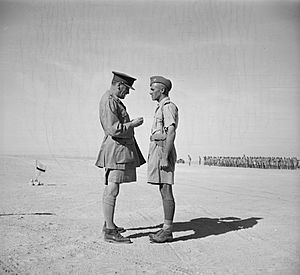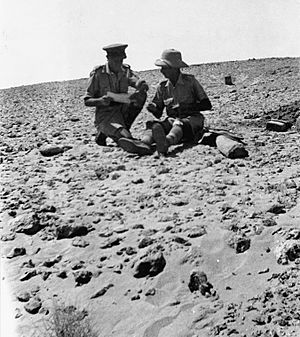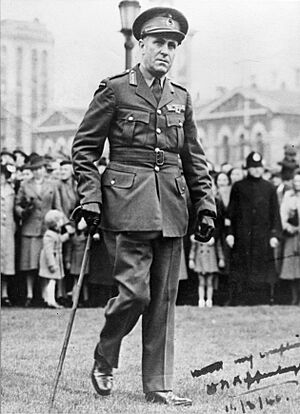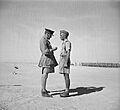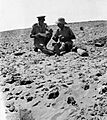Howard Kippenberger facts for kids
Quick facts for kids
Sir Howard Karl Kippenberger
|
|
|---|---|
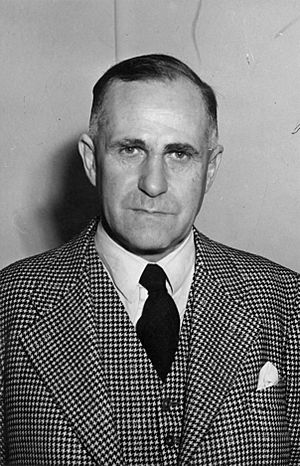
Portrait of Sir Howard Kippenberger in 1952
|
|
| Nickname(s) | "Kip" |
| Born | 28 January 1897 Ladbrooks, New Zealand |
| Died | 5 May 1957 (aged 60) Wellington, New Zealand |
| Allegiance | New Zealand |
| Service/ |
New Zealand Military Forces |
| Rank | Major General |
| Commands held | 2nd New Zealand Division 5th Infantry Brigade 10th Infantry Brigade 20th Battalion |
| Battles/wars | First World War |
| Awards | Knight Commander of the Order of the British Empire Companion of the Order of the Bath Distinguished Service Order & Bar Mentioned in Despatches Efficiency Decoration |
| Other work | Editor-in-Chief, War History Branch |
Sir Howard Karl Kippenberger (28 January 1897 – 5 May 1957) was a brave and respected New Zealand Army officer. People often called him "Kip." He fought in both the First World War and the Second World War.
Born in Canterbury, New Zealand, Kippenberger joined the army in 1915. He fought in France during World War I and was seriously wounded. After recovering, he became a solicitor (a type of lawyer). In 1924, he joined the Territorial Force, a part-time army, and quickly rose through the ranks.
When World War II began, Kippenberger led the 20th Battalion. He guided his troops through tough battles in Greece and Crete, and later in North Africa. He became a brigadier and then a Major General, leading the 2nd New Zealand Division in the Italian Campaign. In 1944, he was badly injured by a land mine and lost both his feet. After the war, he became the Editor-in-Chief for New Zealand's official history of World War II. He worked on this important project until he passed away in 1957.
Contents
Early Life and Army Start
Howard Kippenberger was born on 28 January 1897 in Ladbrooks, New Zealand. He was the oldest of five children. His family's unusual last name came from his great-grandparents, who moved to New Zealand from Germany.
Howard went to local schools, where his father was a headmaster. When he was 14, his family moved to Oxford to become farmers. Howard then went to Christchurch Boys' High School. He was very smart but often misbehaved and didn't attend school much. Because of this, he was asked to leave high school and went to work on the family farm.
Howard was always interested in military history. He joined the local New Zealand Cadet Corps and really enjoyed being a soldier. Even though his father didn't approve, Howard joined the New Zealand Expeditionary Force (NZEF) in late 1915. He was only 18, but he pretended to be older so he could fight overseas.
First World War Experience
From January to April 1916, Kippenberger trained at Trentham Military Camp. He then sailed for Europe to join the New Zealand Division. His ship was sent to Egypt first, where he trained for two months. In July, he moved to England for more intense training.
Fighting on the Western Front
Kippenberger arrived on the Western Front in September 1916 as a private soldier. This was during the big Somme Offensive. He fought in the Battle of Flers-Courcelette, which started on 15 September. He stayed on the front lines for over three weeks. His unit lost many soldiers; after the battle, only five men were left in his platoon.
After a break, his unit moved to the Fromelles area. Kippenberger volunteered to be a sniper, even though he wasn't known for his shooting skills. On 10 November 1916, he was badly wounded in the arm by shrapnel (pieces of an exploding shell). His injury was so serious that he was sent back to New Zealand and left the army in April 1917.
Life as a Civilian
After the war, Kippenberger decided to become a lawyer. In 1918, he started studying law at Canterbury College and worked as a law clerk. He met Ruth Isobel Flynn, a secretary, and they married in 1922. They had three children. He studied in the evenings and became a solicitor in 1920. He then moved to Rangiora, where he managed and later became a partner in a law firm.
Kippenberger was very active in the Rangiora community. He served on the local council and joined many committees. He also kept his interest in the military. In 1924, he joined the Territorial Force. He believed another big war would happen in Europe and wanted to be ready. He built a large military library and studied how wars were fought. He even had a sand table in his office to practice war games! He used what he learned in his training with the Territorials. By 1936, he was a lieutenant-colonel, leading the 1st Battalion of the Canterbury Regiment.
Second World War Service
When the Second World War started in 1939, Kippenberger was given command of the 20th Battalion. This battalion was part of the 2nd New Zealand Division. After training, they left for the Middle East in January 1940. They arrived in Egypt in February and spent almost a year training and guarding areas.
Battles in Greece and Crete
In 1941, the British government sent troops to support Greece against a German invasion. Kippenberger's 2nd New Zealand Division was among them. His battalion prepared defenses, but Kippenberger worried the line was too wide to defend well. He planned ways for his troops to retreat if needed. When the Germans attacked on 6 April, they advanced quickly. Kippenberger's brigade had to pull back to better defensive positions.
The Germans attacked again on 14 April. Kippenberger's battalion defended for three days before retreating. His battalion was chosen to be the rearguard, meaning they protected the main group as it pulled back. He personally helped destroy bridges to slow the Germans down. He and his team even came under fire but managed to rejoin their battalion. On 28 April, Kippenberger and his men were evacuated to Crete.
On Crete, Kippenberger was promoted to temporary colonel and given command of the 10th Brigade. This group was made up of different units, including his own 20th Battalion.
When the Germans invaded Crete on 20 May, Kippenberger was surprised to see hundreds of paratroopers falling from the sky. He quickly reacted. As he headed to his headquarters, a paratrooper shot at him. Kippenberger twisted his ankle to avoid the bullets, then found and killed the paratrooper. His brigade was positioned near Maleme airfield. He wanted to counterattack the scattered paratroopers, but his request was denied.
Over the next few days, there were many attacks and counterattacks. Kippenberger was important in keeping his troops disciplined, even though most were not trained infantry. When the town of Galatas fell to the Germans on 25 May, he quickly planned and led a successful counterattack to take it back. This success was short-lived, and the town was soon abandoned. Kippenberger joined his 20th Battalion as they retreated to Sphakia on the south coast, where they were evacuated to Egypt. He had to choose some men to stay behind as a rearguard, but thankfully, they were able to follow the next day.
Because of his actions in Greece and Crete, Kippenberger became known as one of the best officers in the 2nd Division. He later received the Distinguished Service Order (DSO) for his leadership during the Battle of Crete.
Fighting in North Africa
Back in Egypt, Kippenberger worked to rebuild his battalion, which had lost more than half its men. They trained hard in the desert for several weeks.
Operation Crusader
In November 1941, Kippenberger's 2nd Division took part in Operation Crusader. His battalion had early successes, even capturing 300 prisoners in one battle. On the night of 25 November, he was tasked with capturing a hill called Belhamed. He made a navigation mistake, and his headquarters company got separated. It took him until daylight to find the rest of his battalion, which had already taken the hill with few losses. He was wounded by machine gun fire while checking on his men. He was taken to a medical station but was captured by German forces three days later. From a distance, he sadly watched through binoculars as his 20th Battalion was destroyed in a counterattack.
The medical station was then guarded by Italians. Kippenberger didn't want to be sent to a prisoner-of-war camp in Italy. On 4 December, he and 20 others managed to escape by stealing a truck. On his way back, he met a group of South African armored cars, who helped him reach Baggush. There, he met General Freyberg, who was very happy to see him. Freyberg immediately promoted Kippenberger to brigadier and gave him command of the 5th Infantry Brigade. Kippenberger also convinced his superiors to send a unit back to rescue the remaining prisoners. He was later mentioned in official reports for his work during the campaign.
The 5th Brigade was seen as not as good as other brigades, so Kippenberger worked hard to improve it. They spent months training and building defenses. In April, the brigade moved to Syria to rejoin the 2nd Division.
Battles at El Alamein
Two months later, the Germans attacked into Libya, and the 2nd New Zealand Division was called back. The British army was defeated and retreated into Egypt. The New Zealanders defended a position at Minqar Qaim and fought off several attacks. They were cut off but managed to break out with few losses and moved to new positions at El Alamein.
On 14 July 1942, during the First Battle of El Alamein, Kippenberger led the 5th Brigade in the Battle of Ruweisat Ridge. This ridge was held by the enemy and was very important. Kippenberger's brigade was to capture the center of the ridge. British tanks were supposed to support them, but there was poor communication between the infantry and tank units.
Kippenberger's attack involved a 6-mile night advance. He used two battalions, the 21st and 23rd, with the 22nd in reserve. However, he used unreliable radios and didn't make it clear to the new commander of the 21st Battalion that they didn't need to cover the whole front. The battalion spread out too much, lost cohesion, and bypassed many enemy strong points.
In the morning, the British tanks were not there, and the artillery couldn't break through. Kippenberger's brigades were exposed on the ridge. He saw his battalions under fire from German tanks. Unable to contact other units by radio, he bravely drove under fire in a vehicle to find the British tanks. He found them 4 miles away and begged their commander for help. By the time the tanks arrived, many of his men had been killed or captured. Kippenberger was very upset about the poor planning and admitted his own mistakes. He received another award (a Bar to his DSO) for his courage in seeking help.
On the first day of the Second Battle of El Alamein, Kippenberger led his brigade in a successful attack on Miteirya Ridge. This time, he set up his headquarters as close to the front as possible to avoid communication problems. His 23rd Battalion advanced so quickly that they went past their objective, thinking they hadn't reached it yet! The battalion commander said Kippenberger's inspiring speech before the battle made his men too eager.
Tunisia and Home Leave
As the Germans retreated, Kippenberger and his men pursued them into Libya and Tunisia. After a tough battle at Takrouna, the 5th Brigade was pulled back from the front lines, having lost 38% of its strength. Kippenberger remained a highly respected officer and sometimes took command of the 2nd Division when General Freyberg was away.
In July 1943, it was decided to send 6,000 long-serving soldiers back to New Zealand for three months' leave. Kippenberger was the highest-ranking officer in this group. Because he was well-known for his bravery, he spent much of his leave giving speeches. He became very tired and fell seriously ill in September. He didn't return to command the 5th Brigade until November.
Fighting in Italy
By this time, the 2nd New Zealand Division was fighting in Italy. Kippenberger's 5th Brigade was ready to attack across the Sangro River. When he arrived, he looked at the land and suggested adding another brigade to the attack plan, which General Freyberg agreed to. The attack on 28 November was successful with few losses. The 2nd Division then tried three times to capture the town of Orsogna. The second attack on 7 December involved the 5th Brigade. Even though Kippenberger's brigade achieved its goals, the overall attack failed because another brigade couldn't capture Orsogna itself.
Another attack involving the 5th Brigade on 14 December also failed. Kippenberger found the close fighting in the mountains of Italy very different from the open deserts of North Africa. Despite this, he remained the best of the division's brigadiers. He wasn't afraid to speak up when given difficult orders. When a British general ordered what Kippenberger thought were wasteful attacks, he voiced his concerns twice.
In early 1944, General Freyberg became commander of the New Zealand Corps for the Battle of Monte Cassino. Kippenberger was promoted to temporary major-general and became commander of the 2nd Division. This was the highest point of his military career. The division moved into the line around Cassino. The first attack by the New Zealanders on 17 February failed, even after the Monte Cassino abbey was bombed (which Kippenberger supported). A second attack was planned but delayed by bad weather. On 2 March, Kippenberger climbed a nearby mountain to get a better view of the Cassino battlefield. Near the top, he stepped on a land mine. It exploded, severely injuring both his legs. One foot was blown off in the blast. He was taken to a medical center, where his other foot and the lower parts of both legs had to be amputated. When the news of his injuries spread, it greatly affected the morale of the 2nd New Zealand Division.
Recovery in England
In April, Kippenberger was moved to a hospital in London to be fitted with artificial limbs. He left the hospital in early September after four months of recovery. His wartime service was recognized that month when he was made a Commander of the Order of the British Empire. In December, he was also appointed a Companion of the Order of the Bath.
Doctors said Kippenberger was only fit for office work, but he still hoped to return to the 2nd Division. However, he was chosen to lead the New Zealand Reception Group. This group helped New Zealand soldiers who were released from prisoner-of-war camps in Germany. They arranged places for them to stay and provided social and medical support before they returned home. Kippenberger worked very hard in this new role. He personally met each group of arriving former prisoners of war. By October 1945, most of the released soldiers had returned to New Zealand, and the Reception Group was no longer needed.
Later Life and Legacy
In 1945, Kippenberger was offered a very important job: Editor-in-Chief of New Zealand's largest-ever publishing project, the Official History of New Zealand in the Second World War 1939–45. The New Zealand government wanted to create a detailed record of New Zealand's role in the war. Kippenberger was highly respected, and the Prime Minister, Peter Fraser, thought he was the perfect person to lead this project. The project involved publishing many books about campaigns, army units, and how the war affected New Zealanders. He returned to New Zealand in 1946 to start this new role and worked on it for the rest of his life. He guided the planning and creation of all the books.
Kippenberger set very high standards for the official histories. He believed in telling the truth and read every draft of every book. He gave helpful feedback to the authors. He was especially interested in the history of his old unit, the 20th Battalion. He wanted the histories to be fair, but it was sometimes hard for him to write about battles he was personally involved in. The book about the Battle of Crete was particularly difficult because it had to analyze the leadership of some of his friends.
The official histories sometimes faced political challenges, especially when the government changed in 1949. But Kippenberger was highly respected by both the government and ordinary New Zealanders. He strongly supported the project and convinced the new government of its importance. He created a positive work environment, even with a tight budget. He was proud that his team produced more books than similar projects in Australia and Great Britain. By 1963, the War History Branch had produced nearly 50 major books.
Kippenberger also found time to write his own book, Infantry Brigadier. It was about his experiences during the war. He started writing it in 1944 and finished most of it by late 1946. It was published in 1949 and was a big success, being translated into seven languages.
In 1948, Kippenberger was made a Knight Commander of the Order of the British Empire, which meant he could use the title "Sir." The same year, he became the President of the Royal New Zealand Returned and Services' Association (RSA), a group for veterans. He held this position until 1955. While RSA president, he caused some debate by speaking out against the All Blacks rugby team's tour of South Africa in 1949. He was against it because Maori players were not allowed to be on the team. He had to apologize for his comments, but many Maori veterans supported him.
In April 1957, his wife became very ill and was hospitalized. She later recovered enough to go home. On 4 May 1957, while getting ready for his wife's return, Kippenberger complained of a headache and then collapsed. He was taken to the hospital in a coma and died the next day from a brain hemorrhage. He was buried on 7 May at Karori Cemetery in Wellington with full military honors. His wife watched his funeral from her hospital window. She passed away ten years later.
Kippenberger's Lasting Impact
After his death, Kippenberger's large library was bought by the New Zealand Army. He loved reading military studies and often wrote notes in the margins of his books. These notes show how he thought about warfare and strategy. His collection is now kept in the Kippenberger Research Library at the QEII Army Memorial Museum in Waiouru. It includes many books on military subjects, especially about wars involving New Zealanders.
In 2006, Victoria University of Wellington created the Sir Howard Kippenberger Chair in Strategic Studies. This helps a professor teach students and research military strategies. The New Zealand Army also has the Kippenberger Scheme. This program allows officer cadets at Linton Army Camp to study at Massey University before becoming officers.
Images for kids


